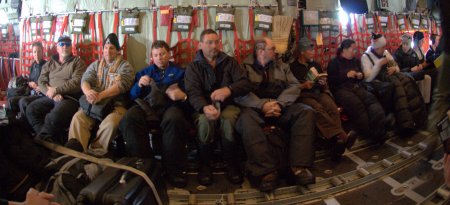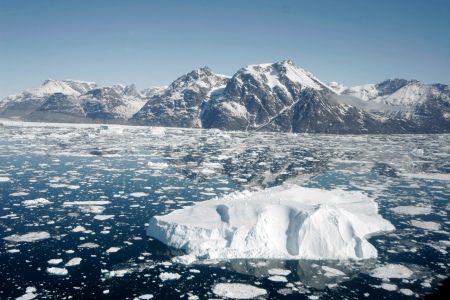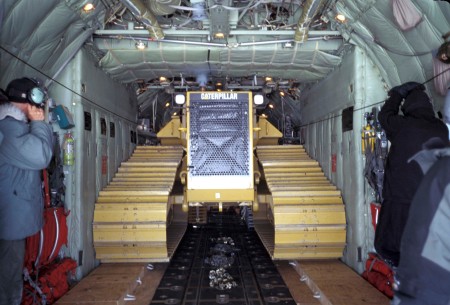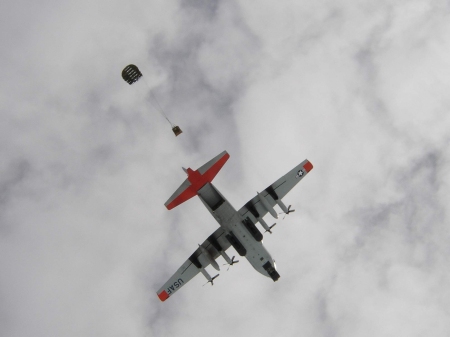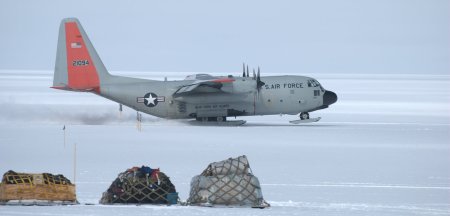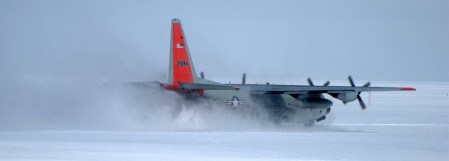
Flags for the United States, Greenland, and Denmark fly at Summit Station for the 2009 Science Education Tour. Photo: Angela Coyle
Like any good educational experience for young people, the 2009 Greenland, Denmark, United States Joint Science Education Tour provided ample play time—in this case, Frisbee games and rounds of golf on the frozen summit of the Greenland ice sheet. The whirlwind tour for a group of Greenlandic, Danish, and American students and teachers highlighted basic research and the effects of climate change on the island’s land, ice, plants and animals (including human ones).
After spending a day orienting in Kangerlussuaq, the group of about 15 flew to Summit Station for a three-day tour of the research outpost at the apex of the ice sheet. Accommodations in the Arctic Ovens of tent city fulfilled a goal for several participants who wanted to sleep atop the two-mile thick ice sheet, though relatively warm temperatures precluded the full experience.

"Room" with a view: Bo Gregersen of the US Embassy in Copenhagen monitors the ice cap from his tent. Photos: Henning Thing (Danish Agency for Science, Technology and Innovation) unless otherwise noted.
In addition to attending presentations given by NSF’s Renee Crain and various Summit scientists and staff and enjoying Summit’s legendary hospitality (including the seemingly bottomless jar of homemade cookies), the group toured Summit’s facilities and science experiments:

While part of the group collected surface snow samples, donning Tyvek suits to reduce contamination of the snow samples which are analyzed for dust and other pollution transported from far away . . .

. . . CPS science technical staffer Steve Munsell explained snow pit science to another part of the group, which then collected samples for snow-density measurements.

Here, students examine the University of Colorado all-sky camera (Koni Steffen, CIRES, PI). Among other uses, information gleaned from the instrument is useful to scientists working to understand the effect of cloud cover on the solar budget.

To learn about ice-core science, the group examined bits of discarded ice core to see the bubbles that contain tiny packets of air from days gone by; they also floated bits of core in orange juice to experience the pop and fizz of the compressed air being released from the melting ice.

Tiny bubbles sparkle in this ice shard.
Greenland had its own lessons to impart. The three-day visit became a four-day visit due to poor local weather. After assembling early in the morning, the team watched for several hours as the flight was delayed under unsettled skies, and then experienced the ultimate trial by fire (or ice fog) when the Air National Guard’s skied LC-130 plane circled over Summit in hopes of a landing opportunity before boomeranging to Kangerlussuaq without picking up the passengers. Instead of flying, the group relaxed with board games, golf, Frisbee and “house-mouse” duties.

In fact, waiting may not be the hardest part.
Jennifer Thompson, a teacher from Juneau, Alaska, was the American group leader. She recorded her experiences in a journal for the ARCUS project, Polar TREC, funded by the NSF. Visit the Polar TREC site to read Jennifer’s blog here.
Danish ecologist and IPY expert Henning Thing escorted the group. After a 40-year career, what Professor Thing doesn’t know about the Arctic probably isn’t worth knowing. Henning’s extensive knowledge of Greenland’s history, culture, and natural phenomena enriched the experience for all. His high-school-aged son participated as well.
 Henning Thing. Photo: Robbie Score
Henning Thing. Photo: Robbie Score

Danish students (L-R) Trine Madsen, Davis Thing, and Sam Hansen snooze in their net seats aboard the Air National Guard's plane on the return to Kangerlussuaq.
The 2009 Greenland, Denmark, United States Joint Science Education Tour was an activity of the Joint Committee. The Joint Committee was established in 2004 to broaden and deepen cooperation among the United States, the Kingdom of Denmark, and Greenland, a self-governing territory of Denmark. Since its launch the Joint Committee has established an impressive track record of accomplishments that spans a broad range of issues of mutual concern, including culture, education, science, environmental research, technical assistance, and commercial affairs. The Joint Committee meets annually (most recently in May, 2009, in Copenhagen, Denmark) to assess its ongoing work and evaluate new project proposals. The Science Education Tour of 2009 was sponsored by the U.S. National Science Foundation, the U.S. Embassy in Copenhagen, and the New York Air National Guard.





 Posted by writer walker
Posted by writer walker 
